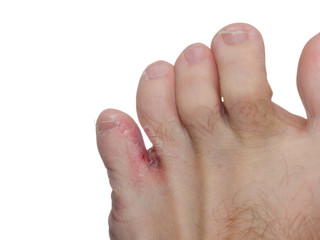Athlete’s foot : All you need to know

What Is Athlete’s Foot?
What Causes Athlete’s Foot?
Athlete’s foot occurs when the tinea fungus grows on the feet. You can catch the fungus through direct contact with an infected person or by touching surfaces contaminated with the fungus. The fungus thrives in warm, moist environments and is commonly found in showers, on locker room floors, and around swimming pools.
Who Can Get Athlete’s Foot?
Anyone can get athlete’s foot, but certain behaviors increase your risk. Factors that increase your risk of getting athlete’s foot include:
- visiting public places barefoot, especially locker rooms, showers, and swimming pools
- sharing socks, shoes, or towels with an infected person
- wearing tight-fitting, closed-toe shoes
- keeping your feet wet for long periods of time
- having sweaty feet
- having a minor skin or nail injury on your foot
What Are the Symptoms of Athlete’s Foot?
- itching, stinging, and burning between the toes
- itching, stinging, and burning on the soles of the feet
- blisters on the feet that itch
- cracking and peeling skin on the feet, most commonly between the toes and on the soles
- dry skin on the soles or sides of the feet
- raw skin on the feet
- discolored, thick, and crumbly toenails
- toenails that pull away from the nail bed
How Is Athlete’s Foot Treated?
Athlete’s foot can often be treated with over-the-counter (OTC) topical antifungal medications. If OTC medications don’t successfully treat the fungal infection, your doctor may prescribe topical or oral prescription-strength antifungal medications. Your doctor may also recommend home treatments to help clear up the infection.
Prescription Medications
- topical, prescription-strength clotrimazole or miconazole
- oral antifungal medications such as itraconazole (Sporanox), fluconazole (Diflucan), or prescription-strength terbinafine (Lamisil)
- topical steroid medications to reduce painful inflammation
- oral antibiotics if bacterial infections develop due to raw skin and blisters
Home Care
Complications
Prevention
These include:
- wash your feet with soap and water every day and dry them thoroughly, especially between the toes
- put antifungal powder on your feet everyday
- don’t share socks, shoes, or towels with others
- wear sandals in public showers, around public swimming pools, and in other public places
- wear socks made out of breathable fibers, such as cotton or wool, or made out of synthetic fibers that wick moisture away from your skin
- change your socks when your feet get sweaty
- air out your feet when you are at home by going barefoot
- wear shoes made of breathable materials
- alternate between two pairs of shoes, wearing each pair every other day, to give your shoes time to dry out between use
It could even be as worse as this :
If you have health, you probably will be happy, and if you have health and happiness, you have all the wealth you need, even if it is not all you want. ~Elbert Hubbard.

